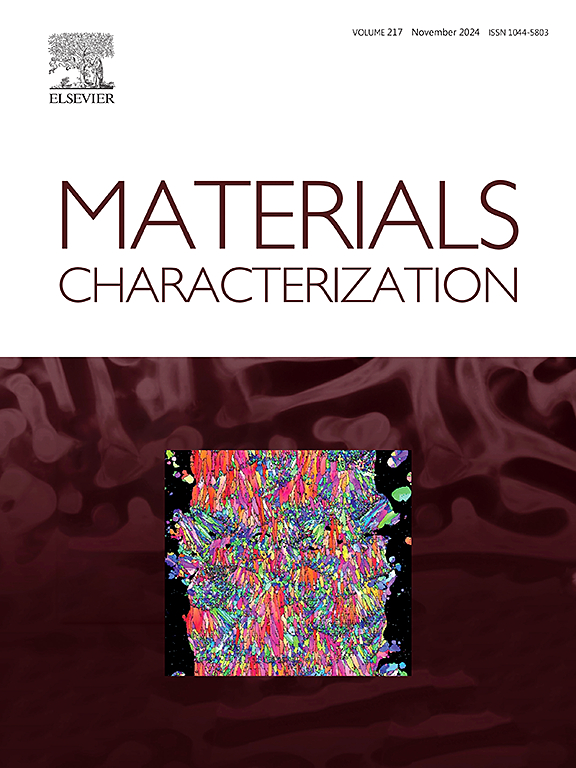Temperature-dependent tribological behavior and interface evolution of plasma sprayed molybdenum coatings
IF 4.8
2区 材料科学
Q1 MATERIALS SCIENCE, CHARACTERIZATION & TESTING
引用次数: 0
Abstract
The present study investigates the dry sliding tribological characteristics and interfacial architecture evolution of atmospheric plasma sprayed molybdenum (Mo) coating deposited on Inconel 718 alloy, over a temperature range of 25 °C (room temperature, RT) ∼ 500 °C. Comprehensive studies reveal that plasma sprayed Mo coating suffers increasing oxidation and strain transition when temperature exceeds 300 °C. In-situ mechanical measurement confirms the Mo coating maintains a desirable thermomechanical stability at the temperature range. The Mo/Al2O3 tribopair exhibits a parabolic trend in friction and wear rate. Specifically, the Mo coating attains a low wear rate (∼10−5 mm3/N·m) at both RT and 500 °C. However, severe wear happens at 300 °C. The worn Mo surface develops a tribolayer primarily composed of MoO2 and MoO3. Despite their presence, these two molybdenum oxides do not effectively reduce friction and mitigate wear when interacting with the Al2O3 surface. Electron Backscatter Diffraction (EBSD) and Molecular Dynamics (MD) simulations demonstrate that the near-surface structure of the Mo coating transforms predominantly due to the compression-induced wear rather than dislocation evolution. Under combined friction and temperature effects, the Mo coating at RT, 300 °C, and 500 °C exhibits variations in crystallographic texture, dislocation density, and dislocation length. Compared to the subsurface characteristics at 300 °C, the near-surface architecture at RT and 500 °C shows higher different orientations under thermal shear stress: (104) at RT, (100) at 300 °C, (213) at 500 °C. It is precisely these dislocation characteristics and texture orientations that contribute to the enhancement of wear resistance at both RT and 500 °C. In conclusion, the coating exhibits temperature-dependent tribological behavior where optimal performance with low friction coefficient (0.39) and wear rate (8.8 × 10−5 mm3/N·m) is achieved at 500 °C due to protective MoO₃-dominated tribolayer formation, while severe wear occurs at 300 °C caused by brittle MoO₂. This study enhances our understanding of high-temperature tribology in Mo-coated mechanical components and the corresponding microstructural changes at tribo-surfaces and interfaces under unlubricated conditions.
等离子喷涂钼涂层的摩擦学行为及界面演化
本研究研究了在25°C(室温,RT) ~ 500°C的温度范围内沉积在Inconel 718合金上的大气等离子喷涂钼(Mo)涂层的干滑动摩擦学特性和界面结构演变。综合研究表明,当温度超过300℃时,等离子喷涂Mo涂层的氧化和应变转变加剧。原位机械测量证实,Mo涂层在温度范围内保持了理想的热机械稳定性。Mo/Al2O3摩擦副的摩擦磨损率呈抛物线趋势。具体来说,Mo涂层在室温和500°C下都具有较低的磨损率(~ 10−5 mm3/N·m)。然而,在300°C时发生严重磨损。磨损后的Mo表面形成了一个主要由MoO2和MoO3组成的摩擦层。尽管存在这两种钼氧化物,但当它们与Al2O3表面相互作用时,并不能有效地减少摩擦和减轻磨损。电子背散射衍射(EBSD)和分子动力学(MD)模拟表明,Mo涂层近表面结构的转变主要是由于压缩磨损而不是位错演变。在摩擦和温度的共同作用下,Mo涂层在室温、300℃和500℃下表现出晶体织构、位错密度和位错长度的变化。与300℃下的地下特征相比,高温和500℃下的近地表结构在热剪切应力作用下表现出更大的取向差异:高温(104)、300℃(100)、500℃(213)。正是这些位错特征和织构取向有助于提高室温和500℃下的耐磨性。综上所述,涂层表现出温度依赖的摩擦学行为,在500°C时,由于形成了保护性的MoO₃为主的摩擦层,涂层具有较低的摩擦系数(0.39)和磨损率(8.8 × 10−5 mm3/N·m),而在300°C时,由于脆性的MoO₂导致涂层发生严重磨损。本研究提高了我们对mo涂层机械部件的高温摩擦学的理解,以及在无润滑条件下摩擦表面和界面的相应微观组织变化。
本文章由计算机程序翻译,如有差异,请以英文原文为准。
求助全文
约1分钟内获得全文
求助全文
来源期刊

Materials Characterization
工程技术-材料科学:表征与测试
CiteScore
7.60
自引率
8.50%
发文量
746
审稿时长
36 days
期刊介绍:
Materials Characterization features original articles and state-of-the-art reviews on theoretical and practical aspects of the structure and behaviour of materials.
The Journal focuses on all characterization techniques, including all forms of microscopy (light, electron, acoustic, etc.,) and analysis (especially microanalysis and surface analytical techniques). Developments in both this wide range of techniques and their application to the quantification of the microstructure of materials are essential facets of the Journal.
The Journal provides the Materials Scientist/Engineer with up-to-date information on many types of materials with an underlying theme of explaining the behavior of materials using novel approaches. Materials covered by the journal include:
Metals & Alloys
Ceramics
Nanomaterials
Biomedical materials
Optical materials
Composites
Natural Materials.
 求助内容:
求助内容: 应助结果提醒方式:
应助结果提醒方式:


